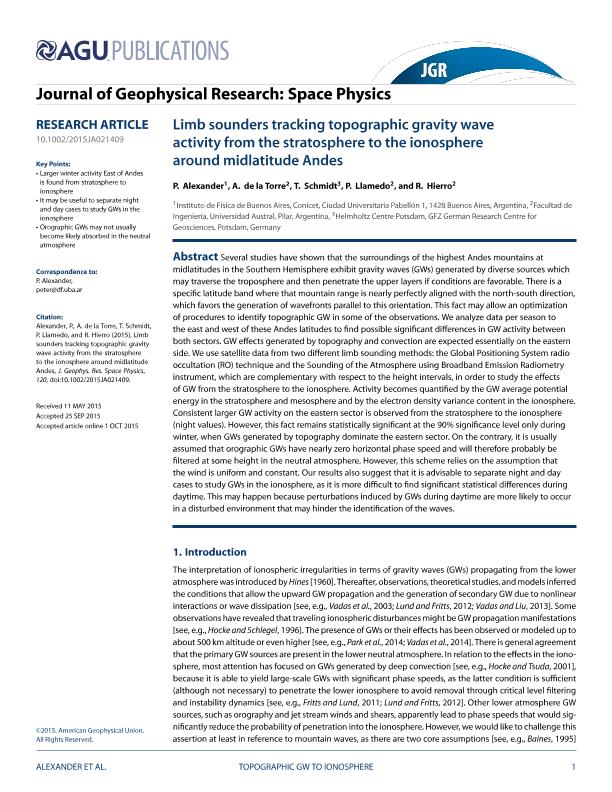Mostrar el registro sencillo del ítem
dc.contributor.author
Alexander, Pedro Manfredo

dc.contributor.author
de la Torre, Alejandro

dc.contributor.author
Schmidt, T.
dc.contributor.author
Llamedo Soria, Pablo Martin

dc.contributor.author
Hierro, Rodrigo Federico

dc.date.available
2018-04-17T17:07:48Z
dc.date.issued
2015-10
dc.identifier.citation
Alexander, Pedro Manfredo; de la Torre, Alejandro; Schmidt, T.; Llamedo Soria, Pablo Martin; Hierro, Rodrigo Federico; Limb sounders tracking topographic gravity wave activity from the stratosphere to the ionosphere around midlatitude Andes; American Geophysical Union; Journal of Geophysical Research; 120; 10; 10-2015; 9014-9022
dc.identifier.issn
0148-0227
dc.identifier.uri
http://hdl.handle.net/11336/42280
dc.description.abstract
Several studies have shown that the surroundings of the highest Andes mountains at midlatitudes in the Southern Hemisphere exhibit gravity waves (GWs) generated by diverse sources which may traverse the troposphere and then penetrate the upper layers if conditions are favorable. There is a specific latitude band where that mountain range is nearly perfectly aligned with the north‐south direction, which favors the generation of wavefronts parallel to this orientation. This fact may allow an optimization of procedures to identify topographic GW in some of the observations. We analyze data per season to the east and west of these Andes latitudes to find possible significant differences in GW activity between both sectors. GW effects generated by topography and convection are expected essentially on the eastern side. We use satellite data from two different limb sounding methods: the Global Positioning System radio occultation (RO) technique and the Sounding of the Atmosphere using Broadband Emission Radiometry instrument, which are complementary with respect to the height intervals, in order to study the effects of GW from the stratosphere to the ionosphere. Activity becomes quantified by the GW average potential energy in the stratosphere and mesosphere and by the electron density variance content in the ionosphere. Consistent larger GW activity on the eastern sector is observed from the stratosphere to the ionosphere (night values). However, this fact remains statistically significant at the 90% significance level only during winter, when GWs generated by topography dominate the eastern sector. On the contrary, it is usually assumed that orographic GWs have nearly zero horizontal phase speed and will therefore probably be filtered at some height in the neutral atmosphere. However, this scheme relies on the assumption that the wind is uniform and constant. Our results also suggest that it is advisable to separate night and day cases to study GWs in the ionosphere, as it is more difficult to find significant statistical differences during daytime. This may happen because perturbations induced by GWs during daytime are more likely to occur in a disturbed environment that may hinder the identification of the waves.
dc.format
application/pdf
dc.language.iso
eng
dc.publisher
American Geophysical Union

dc.rights
info:eu-repo/semantics/openAccess
dc.rights.uri
https://creativecommons.org/licenses/by-nc-sa/2.5/ar/
dc.subject
Gravity Waves
dc.subject
Gps Radio Occultation
dc.subject
Andes Mountains
dc.subject
Ionosphere
dc.subject.classification
Meteorología y Ciencias Atmosféricas

dc.subject.classification
Ciencias de la Tierra y relacionadas con el Medio Ambiente

dc.subject.classification
CIENCIAS NATURALES Y EXACTAS

dc.title
Limb sounders tracking topographic gravity wave activity from the stratosphere to the ionosphere around midlatitude Andes
dc.type
info:eu-repo/semantics/article
dc.type
info:ar-repo/semantics/artículo
dc.type
info:eu-repo/semantics/publishedVersion
dc.date.updated
2018-04-17T13:48:40Z
dc.journal.volume
120
dc.journal.number
10
dc.journal.pagination
9014-9022
dc.journal.pais
Estados Unidos

dc.journal.ciudad
Washington
dc.description.fil
Fil: Alexander, Pedro Manfredo. Consejo Nacional de Investigaciones Científicas y Técnicas. Oficina de Coordinación Administrativa Ciudad Universitaria. Instituto de Física de Buenos Aires. Universidad de Buenos Aires. Facultad de Ciencias Exactas y Naturales. Instituto de Física de Buenos Aires; Argentina
dc.description.fil
Fil: de la Torre, Alejandro. Universidad Austral. Facultad de Ingeniería; Argentina. Consejo Nacional de Investigaciones Científicas y Técnicas; Argentina
dc.description.fil
Fil: Schmidt, T.. German Research Centre for Geosciences; Alemania
dc.description.fil
Fil: Llamedo Soria, Pablo Martin. Universidad Austral. Facultad de Ingeniería; Argentina. Consejo Nacional de Investigaciones Científicas y Técnicas; Argentina
dc.description.fil
Fil: Hierro, Rodrigo Federico. Universidad Austral. Facultad de Ingeniería; Argentina. Consejo Nacional de Investigaciones Científicas y Técnicas; Argentina
dc.journal.title
Journal of Geophysical Research

dc.relation.alternativeid
info:eu-repo/semantics/altIdentifier/doi/http://dx.doi.org/10.1002/2015JA021409
dc.relation.alternativeid
info:eu-repo/semantics/altIdentifier/url/https://agupubs.onlinelibrary.wiley.com/doi/abs/10.1002/2015JA021409
Archivos asociados
